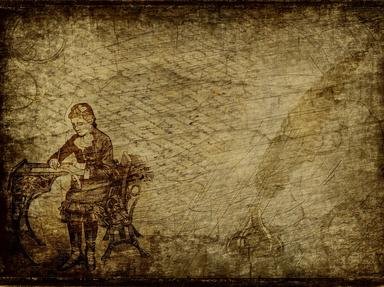Quiz Answer Key and Fun Facts
1. Rest assured that you're not the only one in your quest to make fun of Hemingway's writing-- it's more like a fad that goes in and out of style. Dozens of people through the years have taken the same idea.
Bad Hemingway Tip #1: Learn from the experts. Which of the following authors never wrote a parody of Hemingway?
2. Bad Hemingway Tip #2: Master the art of "shotgun prose," as my English teachers always called it. Let's say that you want to describe a sunrise in your imitation Hemingway story. Which of the following would be the best sentence to use?
3. Bad Hemingway Tip #3: Never tell the whole story flat-out to the audience; instead make them figure out the background ideas and motivations of the characters. Instead of coming out like Nathaniel Hawthorne and screaming "The scarlet letter is a symbol!" you should definitely be more subtle. What name is frequently given to Hemingway's "theory" that only 10% of the story should be easily visible?
4. Bad Hemingway Tip #4: So, you've got your perfect Hemingway scene set up: a summer barbecue party on the back porch. Everyone's having a great time sipping lemonade, enjoying the company of their spouses, and laughing at the dog's crazy antics. Best of all, no children to be found!
No, no, no! Bad Hemingway Tip #4: What's wrong with the scene above?
5. Bad Hemingway Tip #5: Include as many indirect references to Hemingway's work as possible. Use famous quotes, famous scenes, and famous situations.
This is generally a good tactic when imitating any famous author, but it's especially easy for Hemingway. Which of the following is NOT something that could easily be associated with Ernest Hemingway?
6. Bad Hemingway Tip #6: Make sure you've got your characters drawn appropriately. Hemingway's protagonists often share several characteristics. Which of the following people would make a good choice for your bad Hemingway impression?
7. Bad Hemingway Tip #7: There's only one sport that a truly good Hemingway imitation story must include, one which Hemingway discussed in 1932's "Death in the Afternoon." It's also a sport in which the dashing Romero succeeds, much to the chagrin of Jake Barnes and Robert Cohn when they visit Pamplona, Spain in "The Sun Also Rises". Which practice did Hemingway enjoy so much and include in so many of his writings?
8. One of the hardest decisions for all authors to make doesn't regard the plot, or the tone, or even the themes (or lack thereof). The hardest decision is what to call your main character! Hemingway was smart. Rather than spending hours deliberating, he just reused the same character over and over again. That's perhaps insulting to the reader, but makes satire a heck of a lot easier!
Bad Hemingway Tip #8: What name MUST you give to your protagonist, in reference to Hemingway short stories like "In Another Country", "The Killers", and "Indian Camp"?
9. Actually, the MOST difficult decision an author has to make when writing a story is figuring out what title to give it. There are so many good options! Never fear, there is a solution.
Bad Hemingway Tip #9: Imitate one of Hemingway's titles for your own work. It works surprisingly well, believe it or not. See if you can spot the impostor: which of the following is NOT an imitation Hemingway work (Hint: it's not based on a Hemingway title!)?
10. Many of the imitation Hemingway works cited in this quiz come from the International Imitation Hemingway Contest (or Bad Hemingway Contest) which allows authors the chance to do their best at imitating the master at his work. There aren't many rules to participate in that competition: write one page of the best bad Hemingway that you can think of. One stipulation- if you wanted to win the contest, there's one more tip that you would have followed. Now that the contest's done and gone, this tactic is more of a stylistic advantage.
Bad Hemingway Tip #10: What were competitors in the original Imitation Hemingway Contest required to do in their submissions in order to win the prize?
Source: Author
adams627
This quiz was reviewed by FunTrivia editor
looney_tunes before going online.
Any errors found in FunTrivia content are routinely corrected through our feedback system.
